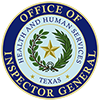Common errors in dental sedation
The Texas Health and Human Services (HHS) Office of Inspector General (OIG) uses referrals and data analytics to identify emerging trends and establish patterns among providers that could indicate potential fraud, waste or abuse. Whether violations are accidental or intentional, it is the OIG’s job to verify that work billed to Medicaid was performed, necessary and met the profession’s standard of care.
In recent months, OIG investigators identified concerns involving the care delivered by some dental providers. Concerns investigated in the fourth quarter of fiscal year 2023 included inappropriate administration of sedation and local anesthesia, discharging the patient before they fully recovered from anesthesia, and billing for sedation levels the provider was not credentialed to perform. The OIG offers the following information to help providers avoid potential issues and mistakes.
Compliance requirements
OIG reviews include an examination of sedation and anesthesia records to ensure compliance with Texas State Board of Dental Examiners (TSBDE) rules and to verify that the standards for patient safety are being met. Both the Texas Medicaid Providers and Procedures Manual (TMPPM) and the TSBDE point to the American Academy of Pediatric Dentistry (AAPD) as the standard of care for treating children that Medicaid providers must follow, including for the administration and documentation of anesthesia and sedation.
Sedation and anesthesia include the administration of:
- Local anesthesia, nitrous oxide or oxygen inhalation.
- Minimal sedation (Level 1).
- Moderate enteral sedation (Level 2).
- Moderate parenteral sedation (Level 3).
- Deep sedation or general anesthesia (Level 4).
To bill and be reimbursed for the procedure code D9248, which may be a Level 1 or Level 2 sedation, a Medicaid provider must hold a Level 2 TSBDE permit to administer either Level 1 or Level 2 sedation.
Errors to avoid
Common pitfalls noted in OIG reviews of sedation and anesthesia services include:
1. Failure to document vital signs as required by TSBDE rules.
- Baseline vitals are required by TSBDE rules for nitrous oxide/oxygen inhalation and all levels of sedation.
- Intraoperative and discharge vitals are required for Sedation Levels 1-4. Providers should refer to TSBDE rules for each level of sedation.
2. Failure to calculate dosages by weight and consider the manufacturer’s recommended dosages or giving all patients the same doses regardless of their weight or age.
- With local anesthesia, while commonly used and generally considered extremely safe, providers must be aware that local anesthetics and sedation both depress the central nervous system. Dosages should be calculated by the patient’s weight. The AAPD recommends calculating downward when administering local anesthesia in conjunction with opioid sedatives.
3. Calculating dosages based on milligrams per pound instead of the typical dose calculation of milligrams per kilogram.
- According to AAPD Monitoring and Management of Pediatric Patient’s Sedation, the patient’s chart shall contain a time-based record that includes the name, route, site, time, dosage/kilogram, and patient effect of administered drugs.
4. Failure to document start and stop times for nitrous oxide or oxygen inhalation and all levels of sedation.
- Refer to TSBDE rules: Chapter 110 Sedation and Anesthesia.
5. Failure to document who administered the medication and names of all staff present during administration of sedation.
- Refer to TSBDE rules for Levels 1-4 sedation.
6. Lack of specific informed consent for nitrous oxide, oxygen inhalation, or sedation procedures.
- Both the TSBDE rules and TMPPM require a specific written informed consent for nitrous oxide or oxygen inhalation and all levels of sedation.
7. Failure to stop the procedure when patient’s vitals indicate a deeper level of sedation than the dentist is qualified or permitted to administer.
- TSBDE rules state “if a patient enters a deeper level of sedation than the dentist is qualified to provide, the dentist must stop the dental procedure until the patient returns to the intended level of sedation.
8. Failure to correctly assess and classify a patient according to the American Society of Anesthesiologists Physical Status Classification system to avoid perioperative risks.
- TSBDE rules state patients must be suitably evaluated prior to any sedative procedure.
Recordkeeping requirements for sedation are extensive. Using a form that covers all requirements is an effective way to ensure compliance. The AAPD provides a thorough form for documenting sedation, which is available to the general public.
If you suspect fraud, waste or abuse in health care delivery, call the OIG Fraud Hotline at 800-436-6184 or use the fraud reporting form on the OIG website, ReportTexasFraud.com.

